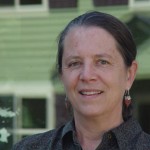Why is Housing Expensive? Builders Know.
Editors Note: This post originated from a discussion about linkage taxes at the presentation of the painting pictured above to honor Martha Rose’s service over the past year as President of the Master Builders Association. Her e-mail reminded me of F. A. Hayek‘s seminal article, The Use of Knowledge in Society, written in 1945. Rose succinctly describes the profound principle of price and knowledge in the market that Hayek expounds in his longer article.
While some may wonder why housing costs are going up, builders in Seattle – often on site at construction projects – know what drives up housing costs.
Even without the proposed linkage fees factored in, the cost to construct a housing unit can be too great, especially for the smaller developers.
Unbendable rules and regulations add huge costs
Every site has different characteristics, but as far as the City is concerned, they are all alike. The paper pushers adhere to multiple sections of fine print in a thousand page tome called the Land Use Code, to find requirements that may be there for a good reason, but make no sense for some sites.
Sometimes the unbending requirements are policies related to infrastructure such as storm water and other utilities, where there is sometimes a logical reason to deviate from the policy of the day.
Here is an example of Land Use Codes and storm water policy run amok: I have a site that consists of a 2-unit row house. It replaces a crumbling duplex, and has not increased density at all. We are in drywall phase and after the New Year, we will tackle street improvements and a storm water tie-in to the main that will add $50,000 to the cost of each of the two new homes.
Here is why this is absurd. Through a variety of green storm water techniques, we managed to mitigate 105% of the storm water runoff from the site. Despite that, the City is insisting that we cut a hole in the storm main in the road so that we can overflow directly into the main. Never mind that there is an inlet abutting the property and it’s entirely feasible to do a curb discharge. In the unlikely event of an overflow, excess water would immediately go into the inlet to the storm main.
The City wants urban villages to be walkable and I agree! However, on my site, there is no access to the west from the two row houses because it is on a dead end that is populated with townhomes on private property. My sidewalk to nowhere has triggered a full Street Improvement Plan (SIP), which is too complicated to cover in this post. Just understand that I will have to rip out an almost brand new asphalt street, several new concrete street panels and 2 perfectly good wheelchair ramps that are “outdated” so that this street meets new standards.
In an email I sent to Mike O’Brien, I summed up the building climate in Seattle this way:
You need to understand that our rising costs are mostly [imposed] by the City, and a vocal minority of angry neighbors, and City electeds who don’t have our backs. This creates a climate that makes building in this town too risky, especially for small developers. The City needs to look at ways to help builders cut costs.
I will not be part of this industry anymore in Seattle. – A fact that would please the neighbors – because that is their goal! So in a way, I don’t care about the trainwreck that is happening with linkage fees, design review, escalating and never ending rules with never ending fees, etc.
I do care about the hypocrisy of the stated goal of sustainability and the opposing actions of some City departments.
Let me reiterate: the Council, the Department of Planning and Development and Seattle Department of Transportation don’t accept responsibility for their roles in the rising costs of building, they don’t care that design review adds layers of costs and they seem oblivious that fees associated with existing and new rules add costs. Besides the shortage of buildable lots, these three items are the number one reason housing prices are becoming so high.
 Martha Rose is outgoing President of the Master Builders Association of King and Snohomish Counties. She is best known by many as the ‘Queen of Green,‘ and is a national leader in the Green Building Movement. She also is owner and operator of Martha Rose Construction. Her interest in energy efficiency and sustainable building practices goes all the way back to the 1970‘s and currently is her main focus. Today Martha is striving toward building Zero-Energy spec-homes.
Martha Rose is outgoing President of the Master Builders Association of King and Snohomish Counties. She is best known by many as the ‘Queen of Green,‘ and is a national leader in the Green Building Movement. She also is owner and operator of Martha Rose Construction. Her interest in energy efficiency and sustainable building practices goes all the way back to the 1970‘s and currently is her main focus. Today Martha is striving toward building Zero-Energy spec-homes.


